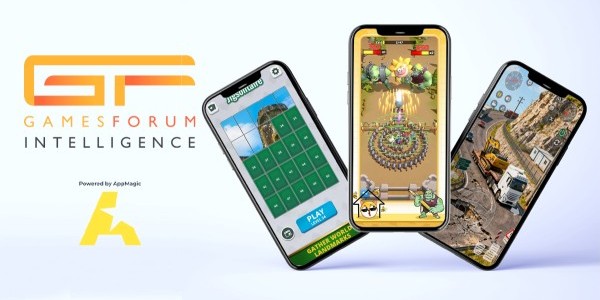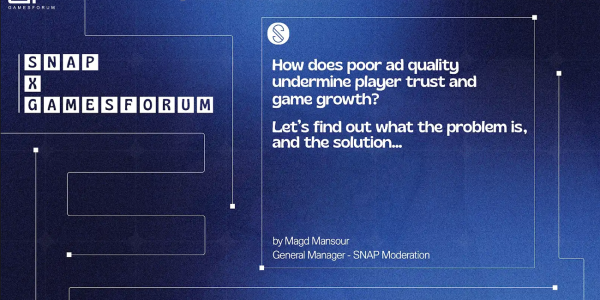Community Spotlight: SocialPeta’s Crystal Bai on AI-Driven Creatives, Influencer Marketing, and Evolving Ad Strategies

For this Community Spotlight, we shine a light on Crystal Bai, Senior Director of Marketing at SocialPeta, as she explores the key advertising trends and insights shaping the mobile gaming industry during the first half of 2024. The interview highlights several notable shifts in the gaming ad landscape, including the increased use of AI-generated content (AIGC), which now accounts for over 40% of image materials in SLG ads. Influencer marketing has also seen rapid growth, with top games leveraging high-profile KOLs to drive user acquisition during launches. Despite a trend of conservative ad spending, frequent creative testing has proven essential, with over 50% of advertisers introducing new creatives monthly to optimize engagement and performance.
All this and more is covered in our in-depth interview, offering a closer look at the innovative strategies driving success in today’s mobile gaming market.
What were the most notable ad creative trends observed in different game genres during H1 for SocialPeta?
Mature and Diverse Use of AIGC: The application of AIGC in mobile game advertising has become more sophisticated and varied. By the end of last year, approximately 10% of image materials for certain SLG advertisements we re AI-generated. By mid-2024, this figure surged to over 40%, highlighting the growing reliance on AI to create engaging and cost-effective ad content.
Increased Use of Influencer Marketing: The role of KOLs in promoting new games has significantly expanded. Many new products leverage the credibility and reach of popular influencers to quickly attract and retain users during the initial launch phase. High-quality influencers are pivotal in driving early adoption and building community around a game.
Conservative Ad Spend and Frequent New Creative Testing: According to the recent "2024 H1 Global Mobile Game Market and Marketing Trends" white paper from SocialPeta, there has been a noticeable shift towards more cautious advertising spending. Despite this, over 50% of advertisers continue to introduce new ad creatives monthly, underscoring the importance of innovation and adaptation in a competitive market. This trend reflects a strategic approach where frequent testing of new creatives is used to optimize engagement and return on investment.
Can you share some successful advertising strategies used by top-performing games, and how these strategies have evolved over the past few years?
Nexters' Unique Approach with Hero Wars: Nexters, particularly known for their flagship game Hero Wars, excels in mobile marketing by leveraging extended video creatives. Their ads, often exceeding one minute in length, focus on digital adventure and battle elements. This approach is rare in mobile game advertising, where shorter clips are typically favored. By extending the duration and incorporating more narrative-driven content, Nexters successfully captivates and engages users.
Emphasis on "mini-game": Sme companies have started focusing on "mini-game" as a strategy to attract players. Unlike previous trends of using misleading ads with gameplay unrelated to the actual game, the current approach integrates mini-game elements into the main game. This strategy not only enhances the overall gaming experience but also provides more honest advertising, aligning user expectations with the actual game content.
Incorporation of "parkour combat" elements in SLG Games: Many SLG titles have adopted "parkour combat" as mini-game feature. This hybrid approach merges traditional SLG gameplay with dynamic, action-oriented segments, creating a more engaging and varied user experience. Notably, some games, like Last War: Survival, incorporate these features right from the development stage, ensuring a seamless integration into the game's core mechanics.
How do ad creatives differ between various game genres, such as RPGs, puzzle games, and strategy games? What unique challenges does each genre present in mobile gaming?
Ad Creative Strategies for Casual and Mid/Hardcore Games
Casual Games: For casual games, especially hyper-casual titles, the primary focus of ad creatives is on showcasing gameplay. These ads emphasize the unique mechanics of the game, making them straightforward to produce. However, the challenge lies in making these ads stand out, as there is limited room for creative innovation in presenting simple gameplay.
Mid/Hardcore Games: In contrast, mid and hardcore games offer a wider range of creative options for advertising. These can include live-action segments, humorous storylines, or in-game content compilations. For instance, RPG ads often highlight storylines and character development, while SLG ads emphasize decision-making and strategy elements. However, the diversity of choices also brings challenges, as these games attract players with varying preferences and expectations. Additionally, regional differences in ad preferences must be considered, as cultural nuances can greatly influence the effectiveness of the creatives.
Did you observe any significant differences in ad creative preferences or effectiveness across different regions? How should marketers adjust their strategies for different markets?
Global Ad Creative Insights for Mobile Games
Use of Live-Action Footage: Live-action footage tends to perform well across different regions, but it is most effective when local actors are used, making the content more relatable to the audience. However, this approach can be costly and may not be easily adaptable for multiple regions due to cultural nuances.
Western Markets Preferences: In Western markets, players generally prefer direct gameplay showcases. However, there's a growing acceptance of exaggerated narrative-driven ads in these regions, indicating a shift towards more engaging storytelling in advertising. Core gamers in these markets often look for challenges and value brand messaging that highlights the game's difficulty and depth.
Asian Market Preferences: In Asian countries like China, Japan, and Korea, there is a higher interest in AI and AR content. Additionally, advertisements in these regions often incorporate strong cultural elements, which resonate well with the local audience. Southeast Asian players, on the other hand, are more inclined towards interactive and entertaining content, making incentivized videos a good choice for engagement.
Use of High-Quality Graphics and CG: Some advertisers have been using high-quality PC game footage or CGI to promote mobile games. While this can generate initial interest, it is crucial to ensure that the in-game experience matches the advertising to avoid damaging the game's reputation, especially in a market increasingly focused on quality and long-term engagement.
Cross-Platform Integration: It's beneficial to create a cohesive marketing strategy that integrates various platforms. For example, in Japan, leveraging local culture and social media platforms for pre-launch promotions can be highly effective.
Data-Driven Strategies: Utilizing tools like SocialPeta's ad intelligence can significantly aid in crafting and refining marketing strategies. These tools help track market trends, analyze competitive landscapes, and optimize ad placements to enhance overall effectiveness.
How do you think emerging technologies, such as AR and AI are influencing ad creative development and deployment in the gaming industry?
The Impact of AI and AR on Ad Creative Production
AI Reducing Production Time: The integration of AI into the ad creative process has significantly shortened production cycles. As AI technology continues to evolve, it may soon allow a single optimization specialist to handle the entire process of creating and deploying ad content. This streamlining of tasks not only saves time but also reduces costs associated with ad production.
AI-Generated Inspiration: AI can also serve as a source of creative inspiration for advertisers. When traditional brainstorming falls short, AI can generate innovative concepts and ideas. While current AI-generated content may still have flaws, the rapid advancements in AI suggest that these tools will only improve, providing even more valuable creative assistance in the future.
Enhanced User Interaction with AR: The inclusion of AR technology in advertising offers a new level of user engagement by allowing content to interact with real-world environments. Imagine future ads not just displaying content but integrating with the viewer's surroundings through AR. This immersive experience is likely to increase user acceptance and engagement, making advertisements more impactful and memorable.
What key performance metrics should marketers focus on when analyzing the success of their ad creatives? Have these metrics changed with the advent of new advertising platforms and technologies?
Ad Creative Metrics:
- Impressions: Measures how often an ad is displayed.
- CVR: The percentage of users who take a desired action after viewing the ad
- CTR: The ratio of users who click on an ad to the number of total users who viewed the ad. These metrics help assess the reach and attractiveness of the ad creative and its ability to draw user attention.
User Acquisition Metrics:
- Installs: The number of times a game or app is downloaded.
- CPI: The cost associated with acquiring a new user through advertising. These metrics are crucial for evaluating the efficiency of user acquisition strategies.
Monetization Metrics:
- Retention Rate : Measures the percentage of users who continue using the app over time.
- ROI: Assesses the profitability of the marketing efforts by comparing the revenue generated to the costs incurred. These metrics are essential for understanding the long-term value of users and the financial success of the campaign.
New Metrics with Emerging Technologies:
- With the rise of short video platforms in the global mobile market, new metrics have become important, such as:
- 3-Second Video View Rate: Measures how many users watch at least three seconds of a video ad.
- Video Completion Rate: The percentage of users who watch a video ad to the end.
- Social Media Engagement Metrics: Includes likes, comments, and shares. These indicators provide insights into user interest and engagement with the video content, and they better reflect the ad's impact and reach on social media platforms.
Based on current trends and data, what predictions can you make about the future of ad creatives in the gaming industry? What new trends or technologies do you foresee becoming influential?
AI's Impact on Cost Reduction and Efficiency: As mentioned earlier, AI technology is increasingly being recognized for its potential to significantly reduce costs and enhance efficiency in mobile game marketing. Particularly in video production, AI can streamline the creative process, enabling faster and more cost-effective production of ad content. As these technologies mature, they are expected to greatly boost the output and quality of creative assets, allowing marketers to quickly respond to market trends and consumer preferences.
Trend Towards High-Quality, Long-Term Game Development: The future of mobile gaming is shifting towards high-quality games and long-term player engagement. Game developers are becoming more focused on building strong brand reputations and ensuring positive player experiences. This shift means that misleading or piecemeal advertising content will become less common, as maintaining a good reputation and player trust is paramount for sustained success in the market.











